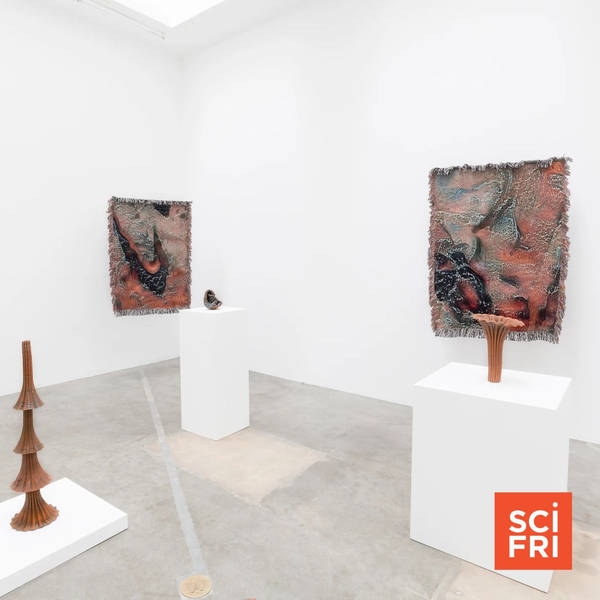
AI Helps Find Ancient Artifacts In The Great Lakes | An Artist Combines Indigenous Textiles With Modern Tech
Researchers in Michigan modeled a prehistoric land bridge and used AI to predict where caribou–and humans–might have traveled along it. Also, artist Sarah Rosalena uses Indigenous weaving, ceramics, and sculpture practices to create art that challenges tech’s future.
Using AI To Help Find Ancient Artifacts In The Great LakesAt the bottom of Lake Huron there’s a ridge that was once above water. It’s called the Alpena Amberley Ridge and goes from northern Michigan to southern Ontario. Nine thousand years ago, people and animals traveled this corridor. But then the lake rose, and signs of life were submerged.
Archaeologists were skeptical they’d ever find artifacts from that time. But then John O’Shea, an underwater archaeologist based at the University of Michigan, found something. It was an ancient caribou hunting site. O’Shea realized he needed help finding more. The ridge is about 90 miles long, 9 miles wide and 100 feet underwater.
“Underwater research is always like a needle in a haystack,” said O’Shea. “So any clues you can get that help you narrow down and focus … is a real help to us.”
That’s where artificial intelligence comes in. He teamed up with computer scientist Bob Reynolds from Wayne State University, one of the premier people creating archaeological simulations. And Reynolds and his students created a simulation with artificially intelligent caribou to help them make predictions.
An Artist Combines Indigenous Textiles With Modern TechWhen multidisciplinary artist Sarah Rosalena looks at a loom, she thinks about computer programming. “It’s an extension of your body, being an algorithm,” she says.
Rosalena, a Wixárika descendant and assistant professor of art at the University of California Santa Barbara, combines traditional Indigenous craft—weaving, beadmaking, pottery—with new technologies like AI, data visualization, and 3D-printing. And she also works with scientists to make these otherworldly creations come to life. She involved researchers at the NASA Jet Propulsion Lab to make 3D-printed pottery with simulated Martian clay. And she collaborated with the Mount Wilson Observatory to produce intricately beaded tapestries based on early-1900s glass plates captured by the observatory’s telescope, which women mathematicians used to make astronomical calculations.
And that’s also a big focus for Rosalena: spotlighting the overlooked contributions women made to computer science and connecting it to how textiles are traditionally thought of as a woman-based craft. When she first started making this kind of art, Rosalena learned that the Jacquard loom—a textile advancement in the 1800s that operated on a binary punch card system which allowed for mass production of intricate designs—inspired computer science pioneer Ada Lovelace when she was developing the first computer program. “[They] have this looped history,” she says. “And when I weave or do beadwork, it’s also recalling that relationship.”
But for Rosalena, there is tension and anxiety in her decision to combine new and ancient mediums. “We’re at this point of the technological frontier and that’s actually terrifying for a lot of people, especially for people from my background and my Wixárika background,” she says. “It’s progress for some, but it’s not for all.”
Part of Rosalena’s work is anticipating future forms of colonization, especially amid rapid change in our planet’s climate and the rise of AI. “What happens when we bring traditional craft or Indigenous techniques with emerging technology to think about current issues that we are facing? Digital technologies are always chasing after ways that we could simulate our reality, which also produces this way that we could re-envision our reality,” she says.
SciFri producer and host of our podcast Universe Of Art D. Peterschmidt sat down with Rosalena to talk about how she approaches her work, why she collaborates with scientists, and how she hopes her art makes people consider today’s technological advancements through an Indigenous lens.
Transcripts for each segment will be available after the show airs on sciencefriday.com.
Subscribe to this podcast. Plus, to stay updated on all things science, sign up for Science Friday's newsletters.
